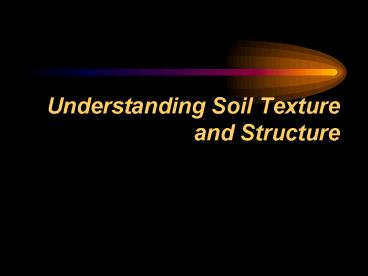Understanding Soil Texture and Structure - PowerPoint PPT Presentation
1 / 17
Title: Understanding Soil Texture and Structure
1
Understanding Soil Texture and Structure
2
Important Terms
- Clods
- Loam
- Peds
- Permeability
- Soil structure
- Soil texture
- Soil workability
- Textural triangle
- Water-holding capacity
3
What is soil texture and why is it important?
- A. Soil texture is the fineness or coarseness of
a soil. It describes the proportion of three
sizes of soil particles. These are - 1. Sand --large particle
- 2. Silt-- medium sized particle
- 3. Clay-- small particle
4
Texture is important because it affects
- 1. Water-holding capacity the ability of a soil
to retain water for use by plants - 2. Permeability the ease with which air and water
may pass through the soil
5
Texture is important because it affects
- 3. Soil workability the ease with which soil may
be tilled and the timing of working the soil
after a rain - 4. Ability of plants to grow some root crops like
carrots and onions will have difficulty growing
in a fine-textured soil
6
(No Transcript)
7
How is the texture of soil determined?
- Soil texture may be determined in one of two
ways - The percentages of sand, silt, and clay may be
tested in the lab. Once tested, you may determine
the textural class of the soil by referring to
the textural triangle. - the ribbon method
8
textural triangle
- There are 12 basic textural classes
- a. Silt
- b. Silt loam
- c. Silty clay loam
- d. Loam contains some of all 3 soil particle
sizes - e. Sandy clay loam
- f. Loamy sand
- g. Sand
- h. Sandy loam
- i. Sandy clay
- j. Clay loam
- k. Silty clay
- l. Clay
9
(No Transcript)
10
the ribbon method.
- a. Fine-textured a ribbon forms easily and
remains long and flexible. - b. Moderately fine-textured a ribbon forms but
breaks into pieces ¾ to 1 inch long. - c. Medium-textured no ribbon forms. The sample
breaks into pieces less than ¾ inch long. The
soil feels smooth and talc-like. - d. Moderately coarse-textured no ribbon forms.
The sample feels gritty and lacks smoothness. - e. Coarse-textured no ribbon forms. The sample is
composed almost entirely of gritty material and
leaves little or no stain.
11
What is soil structure, how does it form, and why
is it important?
- Soil structure is the arrangement of the soil
particles into clusters or aggregates of various
sizes and shapes. - Aggregates that occur naturally in the soil are
referred to as peds, while clumps of soil caused
by tillage are called clods.
12
What is soil structure, how does it form, and why
is it important
- Structure is formed in two steps.
- 1. A clump of soil particles sticks loosely
together. These are created through - a. Plant roots surrounding the soil and
separating clumps - b. Freezing and thawing of soil
- c. Soil becomes wet and then dries
- d. The soil is tilled
- e. Fungal activity
13
What is soil structure, how does it form, and why
is it important
- 2. Weak aggregates are cemented to make them
distinct and strong. Clay, iron oxides, and
organic matter may act as cements. When soil
microorganisms break down plant residues, they
produce gums that also glue peds together.
14
What is soil structure, how does it form, and why
is it important
- Soil structure is important for several reasons
- 1. It improves soil tilth.
- 2. It improves permeability.
- 3. It resists the beating action of raindrops,
minimizing the formation of crusts that reduce
crop stands.
15
What are the various soil structures and what do
they look like?
- There are eight primary types of structure. They
are - A. Granular
- B. Crumb
- C. Platy
- D. Prismatic or Columnar
- E. Blocky
- F. Structureless
- 1. Single grain
- 2. Massive
16
(No Transcript)
17
REVIEW / SUMMARY
- 1. Describe the concept of soil texture and
its importance. - 2. Determine the texture of a soil sample.
- 3. Describe soil structure, its formation, and
importance. - 4. Identify various soil structures.

